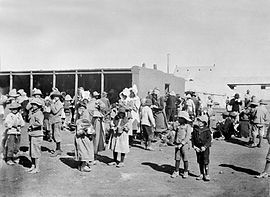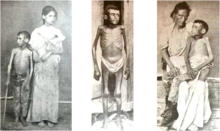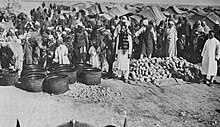|
Concentration camp A concentration camp is a prison or other facility used for the internment of political prisoners or politically targeted demographics, such as members of national or minority ethnic groups, on the grounds of state security, or for exploitation or punishment.[1] Prominent examples of historic concentration camps include the British confinement of non-combatants during the Second Boer War, the mass internment of Japanese-Americans by the US during the Second World War, the Nazi concentration camps (which later morphed into extermination camps), and the Soviet labour camps or gulag.[1] HistoryDefinitionThe term concentration camp originates from the Spanish–Cuban Ten Years' War when Spanish forces detained Cuban civilians in camps in order to more easily combat guerrilla forces. Over the following decades the British during the Second Boer War and the Americans during the Philippine–American War also used concentration camps. The term "concentration camp" and "internment camp" are used to refer to a variety of systems that greatly differ in their severity, mortality rate, and architecture; their defining characteristic is that inmates are held outside the rule of law.[2] Extermination camps or death camps, whose primary purpose is killing, are also imprecisely referred to as "concentration camps".[3]     The American Heritage Dictionary defines the term concentration camp as: "A camp where persons are confined, usually without hearings and typically under harsh conditions, often as a result of their membership in a group which the government has identified as dangerous or undesirable."[4] Although the first example of civilian internment may date as far back as the 1830s,[5] the English term concentration camp was first used in order to refer to the reconcentration camps (Spanish:reconcentrados) which were set up by the Spanish military in Cuba during the Ten Years' War (1868–1878).[6][7] The label was applied yet again to camps set up by the United States during the Philippine–American War (1899–1902).[8] And expanded usage of the concentration camp label continued, when the British set up camps during the Second Boer War (1899–1902) in South Africa for interning Boers during the same time period.[6][9] The German Empire also established concentration camps during the Herero and Namaqua genocide (1904–1907); the death rate of these camps was 45 per cent, twice that of the British camps.[10] Russian campsThe Russian Empire used forced exile and forced labour as forms of judicial punishment. Katorga, a category of punishment which was reserved for those who were convicted of the most serious crimes, had many of the features which were associated with labor-camp imprisonment. According to historian Anne Applebaum, katorga was not a common sentence; approximately 6,000 katorga convicts were serving sentences in 1906 and 28,600 in 1916.[11] These camps served as a model for political imprisonment during the Soviet period. In the midst of the Russian Civil War, Lenin and the Bolsheviks established "special" prison camps and "special" gas chambers, separate from its traditional prison system and under the control of the Cheka.[12][13] These camps, as Lenin envisioned them, had a distinctly political purpose.[14] These concentration camps were not identical to the Stalinist, but were introduced to isolate war prisoners given the extreme historical situation following World War 1.[15] In 1929, the distinction between criminal and political prisoners was eliminated,[16] administration of the camps was turned over to the Joint State Political Directorate, and the camps were greatly expanded to the point that they comprised a significant portion of the Soviet economy.[17] This Gulag system consisted of several hundred[18] camps for most of its existence and detained some 18 million from 1929 until 1953.[19] As part of a series of reforms during the Khrushchev Thaw, the Gulag shrank to a quarter of its former size and receded in its significance in Soviet society.[20] Nazi campsThe Nazis first established concentration camps for tens of thousands of political prisoners, primarily members of the Communist Party of Germany and the Social Democratic Party of Germany, in 1933, detaining tens of thousands of prisoners.[21] Many camps were closed following releases of prisoners at the end of the year, and the camp population would continue to dwindle through 1936; this trend would reverse in 1937, with the Nazi regime arresting tens of thousands of "anti-socials", a category that included Romani people as well as the homeless, mentally ill, and social non-conformists. Jews were increasingly targeted beginning in 1938. Following the Nazi invasion of Poland and the beginning of World War II, the camps were massively expanded and became increasingly deadly.[22] At its peak, the Nazi concentration camp system was extensive, with as many as 15,000 camps[23] and at least 715,000 simultaneous internees.[24] About 1.65 million people were registered prisoners in the camps, of whom about a million died during their imprisonment. The total number of casualties in these camps is difficult to determine, but the deliberate policy of extermination through labor in many of the camps was designed to ensure that the inmates would die of starvation, untreated disease and summary executions within set periods of time.[25] In addition to the concentration camps, Nazi Germany established six extermination camps, specifically designed to kill millions of people, primarily by gassing.[26][27] As a result, the term "concentration camp" is sometimes conflated with the concept of an "extermination camp" and historians debate whether the term "concentration camp" or the term "internment camp" should be used to describe other examples of civilian internment.[28] Other campsAlso during World War II, concentration camps were established by Italian, Japanese, US, and Canadian forces. The former label continues to see expanded use for cases post-World War II, for instance in relation to British camps in Kenya during the Mau Mau rebellion (1952–1960),[29][30] and camps set up in Chile during the military dictatorship of Augusto Pinochet (1973–1990).[31] According to the United States Department of Defense as many as 3 million Uyghurs and members of other Muslim minority groups are being held in China's internment camps which are located in the Xinjiang region and which American news reports often label as concentration camps.[32][33] The camps were established in the late 2010s under Chinese Communist Party general secretary Xi Jinping's administration.[34][35] See also
References
Further reading
External links
|